

Irish Journal of Technology Enhanced Learning Vol 8, Issue 1
Anna Scanlan*
iEd Hub, College of Medicine and Health,
University College Cork,
Cork, Ireland
https://orcid.org/0000-0002-9923-9139
Creating procedural videos through a first-person perspective is recommended to enhance learning for complex tasks in the field of STEM (Fiorella, van Gog, Hoogerheide & Mayer, 2017). While the medical disciplines feature strongly in research for the use of videos to augment training in complex surgical procedures, there is less evidence for the direct development of bespoke videos for (bio)pharmaceutical science laboratory procedures and equipment protocol. Furthermore, there is little research to guide instructors in the step-by- step creation of videos, from recording to editing and delivery, especially for the industrial life sciences. Here, an elegant model is presented providing a detailed outline of the steps taken to produce standard operating procedure (SOP) videos incorporating first-person perspective, using an iPad and multi-angle view Scotia Medical Observation and Training System (smotsTM) cameras in a university School of Pharmacy’s ‘Aseptic Training Suite.’ The objective of these videos is to reduce lab training time and time to competency in the (bio)pharmaceutical industry workplace. However, the process of creating these videos is applicable to many disciplines and sectors for training that involves a procedural element.
Instructional Videos; STEM Education; Postgraduates; Interdisciplinary projects; Simulations; Teaching/learning strategies; First-Person Perspective.
Generally, in the sciences, students at undergraduate level are provided information prior to each laboratory practical to explain the theoretical basis and to outline lab protocol.
Subsequently, students typically run experiments in pairs and under the close supervision of alab demonstrator who mentors the students, immediately corrects mistakes or misconceptions, provides direct one-to-one feedback and tests the student’s knowledge and understanding throughout the practical. Hence, training and knowledge testing in addition to demonstrating the technical steps of the experiment can be time consuming. In contrast to the undergraduate experience, postgraduate students progress sharply to a more independent way of operating within a lab, with less supervision and more individual responsibility.
However, the initial introductory training for equipment and procedures still demands considerable time investment to bring students up to industry standard. On entry to the biopharma manufacturing and operations industry, graduates are introduced to the use of highly specialised equipment and processes. The ideal route is through a Graduate Entry Programme which typically involves mentoring students over a 2-year period to scaffold workplace training and integration. Therefore, the overall time to competency can be quite protracted.
Apart from the technical skills that must be adapted or acquired, graduates must adhere to stringently systematic protocols for operating equipment and for working within different grades of aseptic environments. Such workflows are governed as part of a risk-based quality management system in industry by ‘Standard Operating Procedures’ (SOPs) (European Medicines Agency, 2024). SOPs are detailed guidelines which must be followed in a sequential step-by-step order and often include diagrams. Incorrect use of equipment and software, or deviation from protocol, can lead to expensive losses in terms of time, money, product or staff turnover. Therefore, SOPs are mandated in the biopharma industry internationally (and much of MedTech) and for compliance with EU-GMP and the FDA GMP Compliance. (n.d.). As such, SOP practice is an essential industry workplace skill.
Much research has emerged from medical disciplines advocating the benefit of videos to augment training and skills acquisition, with SOP style videos being common for communicating complex surgical procedures (Green, Suresh, Bittar, Ledbetter, Mithani & Allori, 2019; Krumm, Miles, Clay, Carlos II & Adamson, 2022). Although biopharma also relies on stringent adherence to SOPs, the same adoption of video technology as seen in medical disciplines and literature, has not transferred to education in the biopharma life sciences (Abu Farha, Rashad, Hasen, Mukattash, Al-Hashar & Basheti, 2020). Empirical studies demonstrate that learning can increase to a statistically significant level when video interventions are employed compared to non-video interventions (Green et al., 2019; Karic, Moino, Nolin, Andrews & Brisson, 2020). Further evidence shows that viewing videos of ‘to-be-performed’ actions in advance of a laboratory practical (Dunne, Bree, Duggan & Campion, 2020) or surgical operation (Green et al., 2019) improves operational performance. This corroborates with prior research conducted by Fiorella et al., (2017) revealing a ‘perspective effect’ on learning, whereby viewing to-be-performed actions from a first-person angle can increase learning for complex tasks. Research has also increased to show what works and does not work in producing instructional videos (Clark & Mayer, 2008; Fiorella & Mayer, 2018). Castillo, Calvitti, Shoup, Rise, Lubbock and Oliver (2021) provide detailed tips for general video production and elucidate common video production terms (e.g., aspect ratio, HD etc.) while Dunne et al., (2020) advise using closed captions and annotations for greater accessibility, suggesting that such videos be integrated into online modules in preference to sharing as once-off videos. Yet, there is little to provide a step-by-step walk-through of the full video production process from recording to final edits, especially when applied realistically within an educational science lab setting.
Considering that Ireland is the third largest exporter of pharmaceuticals globally, with an expected increase of 10,000 jobs in the sector before 2030 (IBEC, 2022), it is essential that education produces graduates that are swiftly and reliably competent in process protocols and in the use of common industry equipment such as isolators, air particle counters, validation systems and so forth. On consideration of the evidence, a decision was made to record SOP style videos of laboratory techniques from a first-person perspective (first-person perspective), on pilot scale industry equipment in a university’s School of Pharmacy. The aim was to produce SOP videos that provide greater clarity around the objectives and performance expectations for practicals, to support student fluency in communication and performance, and to foresee and pre-empt potential problems before they arise.
An important reflective process according to Wu & Rau (2019), is to challenge illusions of learning by providing an ‘expert’ sample for students against which they can compare the progress of their learning and performance. Post lab, students can self-evaluate their understanding and performance in comparison to the ‘expert’ SOP videos. Thus, by providing a pre-practical SOP video, the expectation is that in-lab training time and errors will reduce, enabling students to work with more accountability, independence and confidence.
A lecturer in (bio)pharmaceutical science, two instructional designers (IDs) and a volunteer 2nd year undergraduate pharmacy student participated in this project. The student was briefed that the objective of creating the lab videos was to introduce students to the equipment, to reduce training time and to provide them with a resource they could return to repeatedly for learning. She was told the focus would be on capturing photos and footage from a first- person perspective and the rationale behind this was explained. A resident AV/IT specialist with experience in producing medical simulations was consulted to guide on suitable equipment for video recording in a first-person perspective. The use of smotsTM cameras (Scotia UK, n.d.) was deemed most appropriate, supplemented with an iPad for photography and filming (see Table 1). SmotsTM cameras are akin to surveillance cameras which can be set up to capture different angles from within a room and for different zoom levels, while simultaneously recording and/or live-streaming footage and audio. The set of smotsTM cameras acquired included three cameras, a laptop and all necessary accessories including tripods, in handheld roller suitcases. Video editing software requiring a paid subscription included a 3-year team’s licence for Adobe CC apps (multiple version updates throughout 2023 and 2024) and Camtasia Studio (Version: 2023.4.8). The free audio editing software, Audacity (Versions 3.3 to 3.4.2) was also used.
| Equipment | Serial No. | Model No. | Serial No. Model No. Manufacturer |
|---|---|---|---|
| Cameras | Camera 1: B8A44F4DD368 Camera 2: B8A44f4DD15B Camera 3: B8A44F4DD0F7 |
SC742HD3V | Scotia UK plc |
| Laptop | Laptop 702049; Laptop ST 29F4KL3 | smotsTM InSitu | Dell |
| iPad Air 5th Generation | VL649649FY | MM9L3B/A | MM9L3B/A Apple |
Topics and dates for recording were planned in advance with the lecturer and student volunteer, both of whom were to act as operators within the videos. All recordings took place in the School of Pharmacy labs, University College Cork. Due to page constraints, just two video production processes are outlined here: working within a negative pressure isolator and using a freeze dryer (Appendix A, Fig A.1). These acted as the standard for subsequent recordings. From this point on, smotsTM cameras will simply be referred to as cameras.
Many but not all the steps from Castillo and colleagues (2021) were followed. No additional microphone was necessary as the iPads and cameras recorded decent quality audio. In advance, everyone’s role in the lab was clarified. Cameras were positioned to capture multiple angles of hand actions as follows (Figure 1 a, b, c, d):
on a tripod to capture right-hand side,
within the isolator to capture an elevated view from the left-hand side,
fixed to the chest to capture a first-person perspective,
as a mobile camera (iPad) to capture difficult angles; and to photograph equipment and materials in advance and at key stages throughout.
The latter image also shows the live recording being monitored on the laptop. As recordings progressed, it was only necessary to have one person present to film the operator using one camera and the iPad.
A transcript was not used as both operators were experienced with the procedures and wished to demonstrate naturally. Language was kept informal with use of the word ‘you’ throughout to maximise Mayer’s ‘personalisation effect’ for learning (Clark & Mayer, 2008). This also provided the video with more ecological validity in line with the objectives of the project (Price, Jhangiani, Chiang, Leighton & Cuttler, 2022). Beforehand, the operators were advised to move with slow deliberation as natural movements can appear fast on video. Only minimal directions were given during recording to ensure their hands remained within frame and to avoid unnecessary noise being picked up from the sensitive camera microphones. The operator clapped hands to indicate when to start recording and stated when to stop. Initial setup took approximately 30 minutes to identify all optimal angles and to enable the operator practice movements while holding objects at arm’s length while adjusting the bodycam. To reduce retakes, the operator stated when a particular step was to be removed from post- filming edits or individual steps were repeated as necessary rather than redoing entire sequences. Examples of good and poor lab etiquette were included in the demonstration with steps shown for resolving common issues, e.g., glove leaks, poorly positioned items in the isolator, unsheathing needles. For example, if an item was held out of frame, that specific step was repeated as per Figure 2 (a, b). This proved very efficient timewise.
| (a) | (b) | (c) |
|---|---|---|
 |
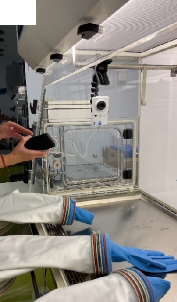 |
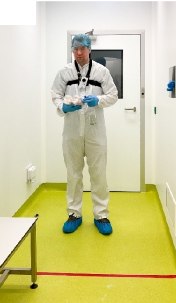 |
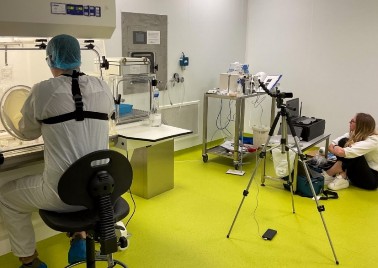 (d) (d) |
| (a) | (b) |
|---|---|
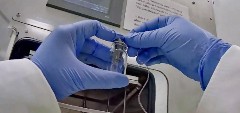 |
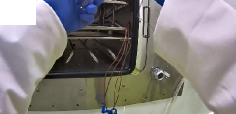 |
Raw footage from the three cameras was saved in MP4 format to an external hard drive (Verbatim 2TB) and uploaded to a team SharePoint folder. Unusable shots were cut from these files using the video editing software Camtasia. Files were labelled according to the camera source: AS1 = tripod, AS2 = bodycam, AS3 = mounted cam, A.cut 1 = iPad. Raw video footage from the iPad was in .MOV format which is incompatible with Windows and required conversion to MP4. Each .MOV video file was uploaded to OneDrive from the iPad, downloaded to a Windows laptop and then imported into Adobe Media Encoder (versions 23 – 24) as per Liverpool John Moores Screen School (2021, March 12). The preset used to convert imported files into MP4 format was “H.264, match source bitrate” (see Appendix A, Fig A.2). These MP4 files were exported to desktop. Image files from the iPad were in HEIC format and were also converted to JPG via Media Encoder. Adobe Lightroom is usable across devices. Photos were imported into Lightroom on the iPad for editing in either iPad or Windows. Once edited, photos were exported from Lightroom in Windows as JPGs and saved to the desktop. A large amount of data was generated in the video production process. To collate content, a master folder titled ‘1. Lab Recording’ was created to house main folders by topic and subfolders by content type as follows:
01 Cleanroom & Isolator | 02 Air Particle Counter | 03 Freeze Dryer |
01 Footage | 01 Footage | 01 Footage |
02 Audio | 02 Audio | 02 Audio |
03 Graphics | 03 Graphics | 03 Graphics |
04 Exports | 04 Exports | 04 Exports |
Once all data was collated and organised, the master folder was saved to an external hard drive, as video files are especially heavy on internal processors and will decelerate a standard laptop’s function significantly. Once organised, files were given more descriptive names to play in sequence and to identify b-roll footage.
For review purposes, an initial draft video was edited in Camtasia combining entry into the cleanroom through a materials airlock hallway and operation of the isolator. The video was approximately 20 mins long. Although the video was not of high quality as its purpose wasfor review, the software repeatedly slowed and froze to the point it would need frequent rebooting. This required repeated engagement with TechSmith (Camtasia) technical support and long delays to video production. Hence, Adobe Premiere Pro was employed which is a more robust video editing software, but which is less intuitive to use than Camtasia and more technical to a professional degree. Adobe Video & Motion (2023) Premiere Pro workshops by Valentina Vee were consulted to upskill in advanced features and her method for video editing and exporting was applied.
The Premiere Pro interface is divided into four main work areas as can be seen in Figure 3. The source monitor shows a preview of files on the upper left and the programme monitor on the upper right shows what the final output view will be. The media bin on the lower left contains all imported files, where files can be organised into folders similarly to a desktop.
The timeline on the lower right is the primary panel for all editing and any alterations appear in real-time in the programme monitor.
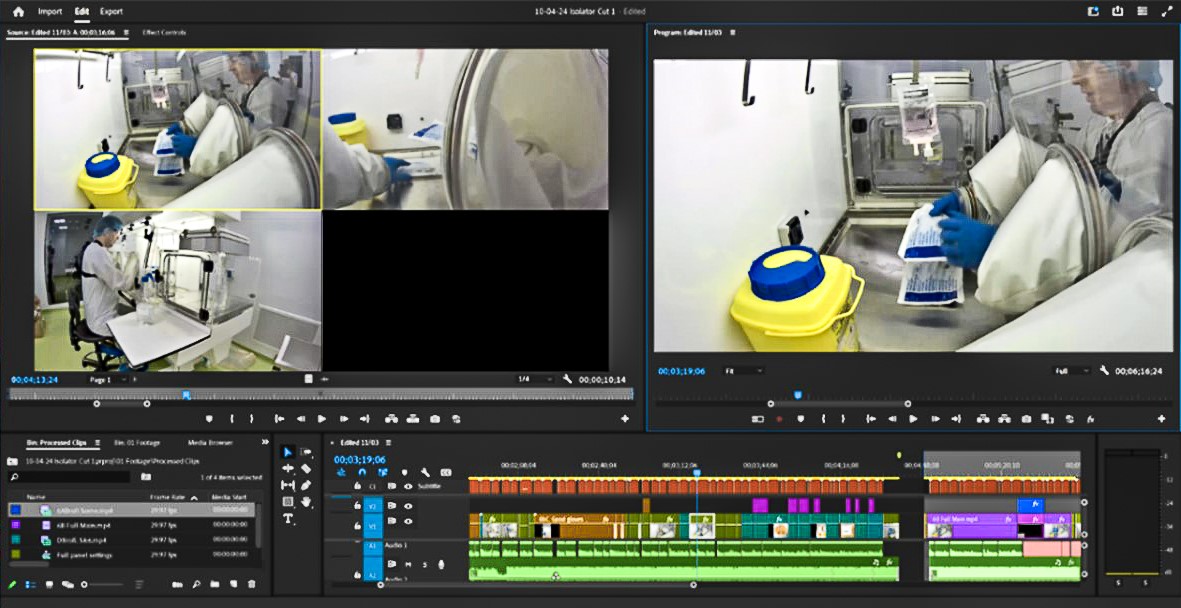
A colour label was applied to files in the media bin (e.g., B was brown, C was purple etc.) for quick visual recognition and organisation during editing across different timeline tracks.Files were dragged directly from the media bin and dropped onto the tracks where they divided automatically as video or audio. The same footage from different angles could be stacked in different tracks on top of each other for simultaneous editing using the multiple- camera toggle tool as illustrated in Figure 3. The multicam sync tool was used to synchronise identical footage from different angles by identifying matching audio waveforms. Once the clearest audio (bodycam) was identified, the audio from remaining cameras was deleted.
Additional panels for editing were accessed by going to the top toolbar, clicking ‘Windows’ and selecting from the drop-down menu. For example, to open a panel for automatic transcription, the ‘Text’ panel was selected. The transcript could be altered from here and because it is directly connected to the timeline, it could also be used for precise cuts in the footage, i.e., if a section of text was deleted, the section of footage synced to that text was also deleted from the timeline (Figure 4). Captions were selected for automatic generation from the text panel. The transcript from the negative pressure isolator was exported to desktop and a voiceover narrated in Audacity as the sound quality in parts was poor due to the background noise of the isolator when operating. The narration from Audacity was exported as a .Wav file and imported back into Premiere Pro as the main audio. Adobe stock music was added to videos via the ‘Essential Sound’ panel, stretched to match the video length and a ducking effect applied to reduce the music volume during dialogue. Adobe tutorials guided these edits.
For final exporting of videos, all footage on the timeline was rendered to ensure smooth playback. Files were exported as H.264 media with separate sidecar captions as .SRT files, as per Adobe Video & Motion (2023). The exported files in MP4 format were saved to the teams’ SharePoint and to the ‘Exports’ folder in the external hard drive. MP4 videos were also uploaded to the teams iEd Hub YouTube channel and .SRT captions uploaded separately following YouTube guidelines.
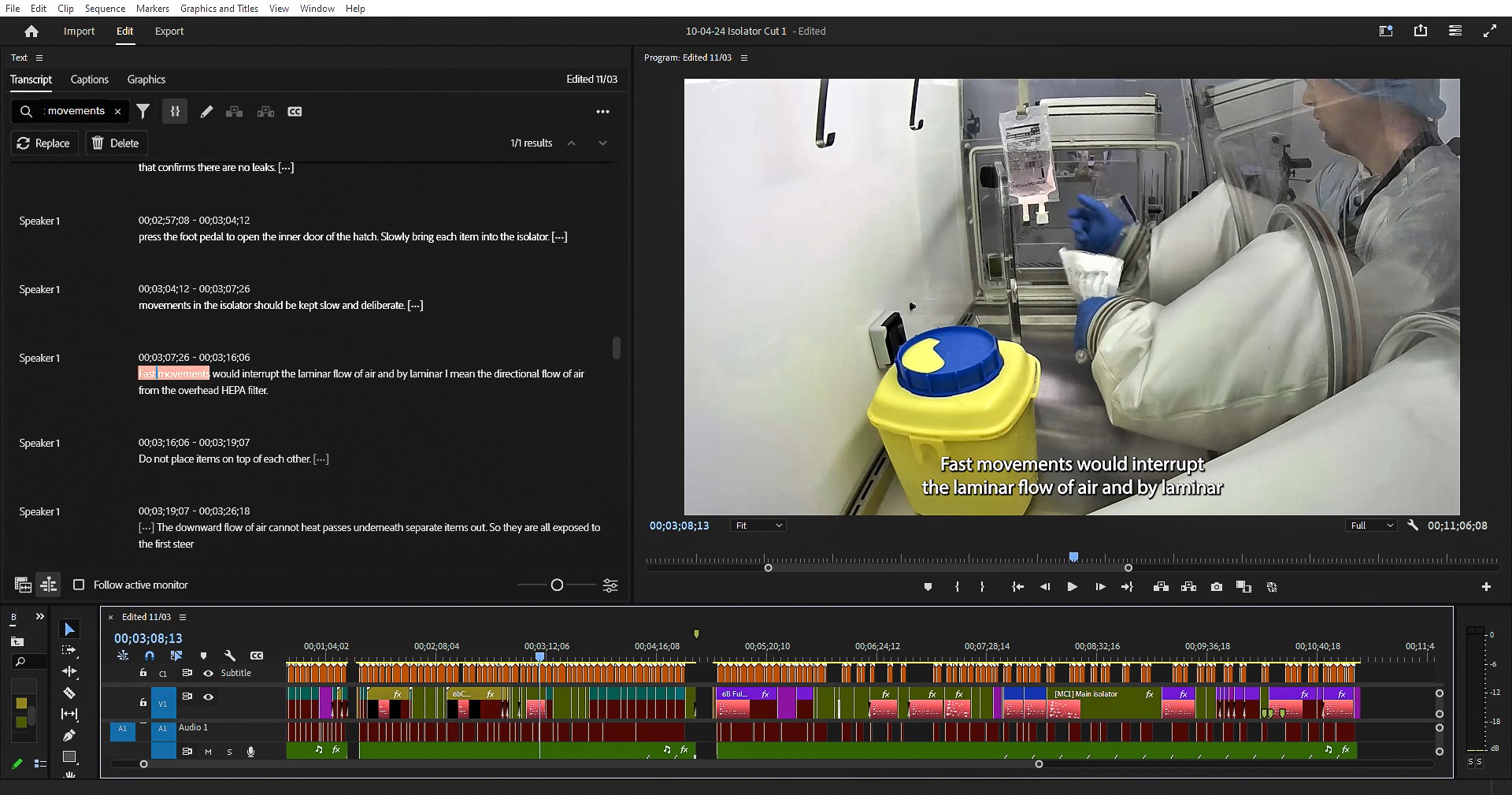
It was necessary to resync some captions manually in YouTube. MP4s from SharePoint were also embedded in Articulate Rise and may be delivered to students through this format or directly from the university’s LMS, Canvas.
Thirteen full videos were shot periodically over a 1-month timeframe. To date, the first three videos have been edited to completion and are ready for dissemination (see Appendix B for the full listing).
An excerpt showing work within an isolator and incorporating a first-person perspective can be viewed via the video on iEd Hub (2024, June 19). A step-by-step workflow of the overall process was developed to guide future production of SOP style videos (Figure 5). A production checklist to guide the practical aspects of recording was also generated (Figure 6), based on a production checklist created by Castillo et al., (2021).
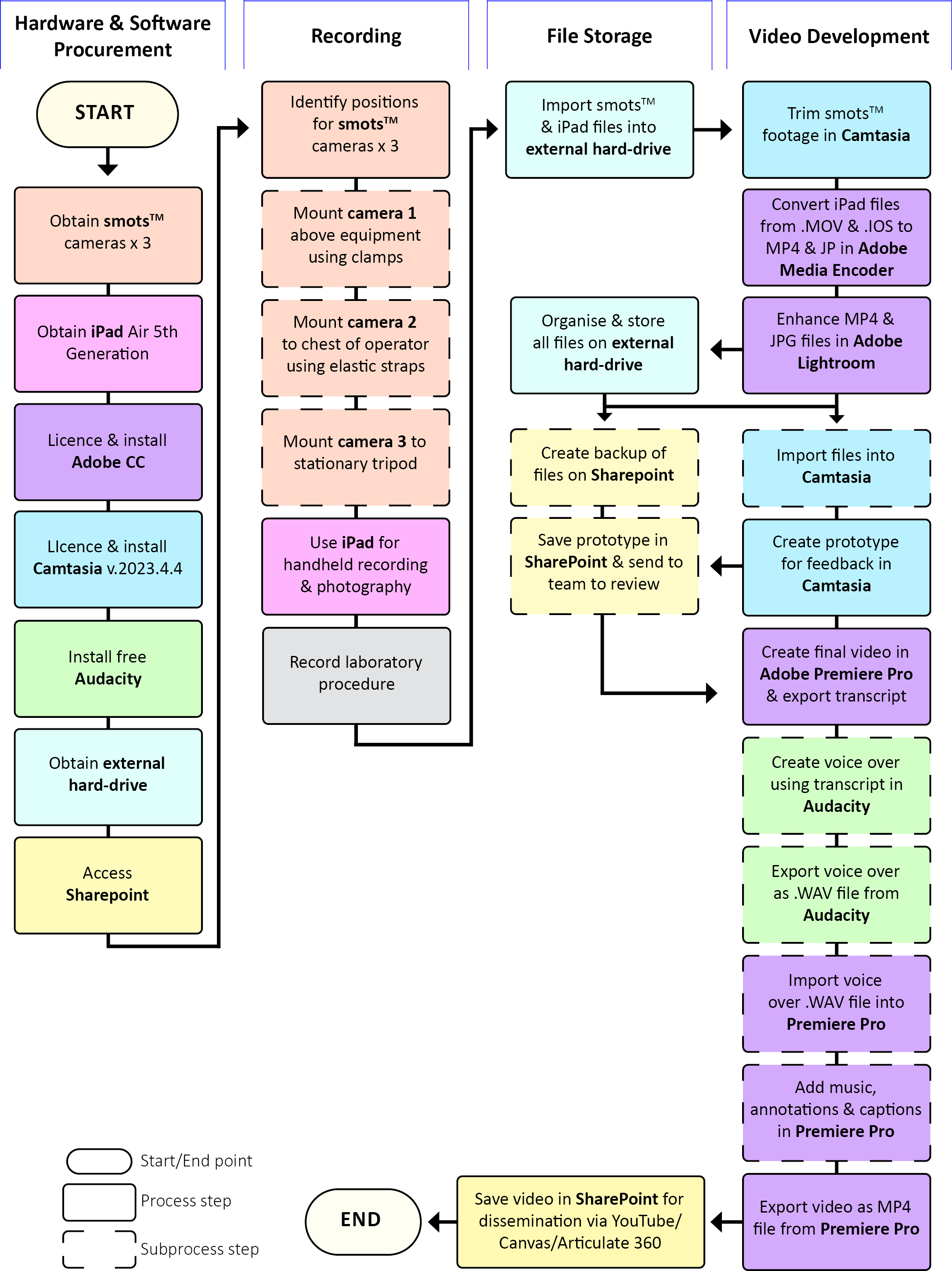
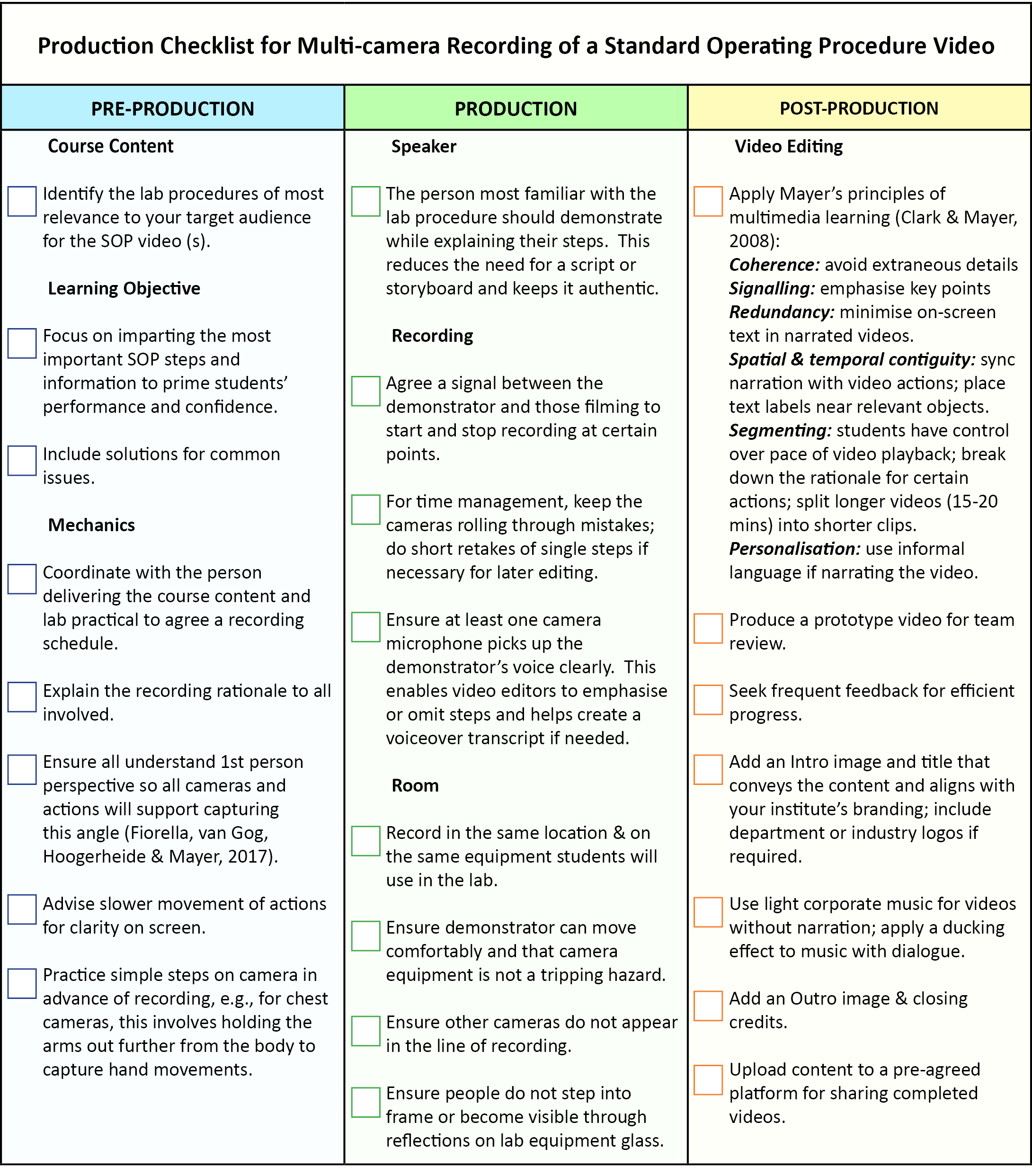
The motivation for producing SOP videos was to familiarise students with equipment in advance of engaging in any procedures and to prime their knowledge for recall in the lab. The expectation is that this may increase students’ confidence and competence while reducing in-house training time and lab errors. The videos will also serve to capture what might be missed in a live training demonstration, enable self-directed and self-paced repetitious views of procedures and to help students appreciate the rationale behind certain steps, e.g., slow movements in an isolator to avoid interrupting laminar airflow and to minimise particle generation.
Obstacles to the production of protocol videos include time, access to relevant facilities, the skillset for video editing software and the financial costs for procuring the necessary hardware, software and associated training if required. As noted by other researchers, the cost of developing online content for research can be prohibitive, but the time required to generate content is perhaps the most inhibitive factor (Gegner et al., 2009). Time was one of the limitations of this project in that the iterative editing and reproduction of draft videos and final videos was particularly time-consuming and required a level of technical skill that not everyone may have time to train for. Overall, the project in its entirety to its current stage took approximately 6-8 months. Beyond the recording stage, the majority of editing was completed by one person approximately 2-3 days/week, who did not have expertise in video production but did have proficiency in Camtasia and Audacity, and a foundation in Premiere Pro. This demonstrates the feasibility of producing bespoke SOP videos as an amateur.
Extensive scoping of educational psychology and neuroscience literature in advance informed best practice for creating videos, being mindful of Mayer’s principles of multimedia (Clark & Mayer, 2008) and Fiorella’s perspective effect (Fiorella et al., 2017).
Many technical difficulties were encountered throughout, which extended editing many months beyond what was planned. For example, it was not known in advance that iPad files were incompatible for direct sharing on Windows devices and it took almost a fortnight to find a solution in Adobe Media Encoder (online media encoders typically have limits).
Initially, the intention was to use SharePoint and OneDrive for file storage and while this was suitable for housing backup files, importing files for editing in Camtasia or Premiere Pro proved unworkable (lag, loss of function, time to import, slow syncing). In addition, Camtasia was unsuitable for editing multiple camera angles and crashed often so was not used beyond the initial draft video. Premiere Pro proved more robust and the rich tutorial resources embedded within Adobe CC apps meant the initial steep learning curve for using advanced features of the software was quickly overcome. The internal storage of the Dell Latitude 5420 64-bit OS with a 1.70GHz processor used for editing was insufficient, hence the need for an external hard drive. One point to note, is that each time a project is reopened in Premiere Pro, the files in the media bin will have to relink with those in the external hard drive. Therefore, it is advisable not to use the hard drive to work across different computers as projects may end up missing original footage in the timeline, an issue that surfaced during this project. Alternative paid storage options for video editing are frame.io and ‘LucidLink.’
In relation to hardware, the smotsTM cameras are a very specific type of equipment and for the most part, served their purpose well. However, a fisheye effect (Figure 7) was caused when cameras were placed too close to the operator, as found by other researchers (Dunne et al., 2020). This may be the result of the team’s lack of experience but the iPad proved best for capturing clear, close-up recordings and photos.
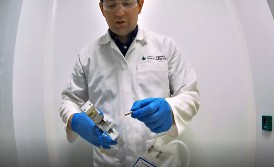
As recordings progressed, the iPad became the primary camera for recording and only one smotsTM camera was necessary to capture a different angle. It is entirely feasible that other educators could follow the flow of steps from this project to record using only iPads, as long as movements are kept to a minimum. The advantage of the smotsTM cameras is that footage is recorded in MP4 format and does not require conversion before editing. Another advantage is that smotsTM cameras could be easily transported by hand in a self-contained roller case and equipment set-up was intuitive and flexible.
Other general considerations for recording in a wider educational context include being mindful to choose operators who are deeply familiar with the SOP for equipment and procedures being filmed. This avoided the need to prepare scripts in advance or for additional training of student actors, as often required for medical simulations such as problem-based learning. Another consideration is to use operators who are comfortable with taking direction and having the bodycam harness repeatedly adjusted on the chest by others. An alternative possibility is to place the camera on headgear. It was helpful to show the operators exactly how their actions translated to live footage from the bodycam. For example, on Day 1 of recording, the top half of recordings from the lecturer’s bodycam was absent some of the time. Hence, on Day 2, the student operator was given two bolts to hold and shown on the laptop screen how her grasp of them appeared from the bodycam view.She was able to adjust her grasp and stretch her arm to what was comfortable and practical while watching the footage live and this helped to position the camera better on her chest.
An observation from editing, is to advise operators to be conscious of using similar words which can be misinterpreted by automatic transcript generation, or which can be difficult to distinguish in audio. For example, the instruction “open up the plates and place them in different parts of the isolator” misinterpreted the words “plates” as “place” and vice versa throughout the full recording. Therefore, text editing required great attention to detail for captions. Clearer statements and conscious pronunciation for more contrasting words are recommended, e.g., “open up the plates and put them in different areas of the isolator.”
In reviewing the literature, a gap was identified for (a) training through the use of SOP style videos in science education and (b) guidance for producing SOP videos. This led to the production of thirteen SOP style videos on pilot-scale industry equipment, related software and procedures. These videos are suitable for implementation in course modules at postgraduate level, prior to graduates entering the lab and workplace. Although these videos are positioned to target students of pharma/biopharma education, the process of their
production is expandable to other disciplines and sectors. As a result, a production checklist and step-by-step set of guidelines have been created for other researchers and educators to follow that are applicable beyond biopharma disciplines. Given the general progression of education to more blended and online formats, a recommendation from this project is for more research to be conducted investigating the role of pre-lab SOP videos in reducing time to competency. Limitations acknowledged include the time spent on data management, upskilling in Premiere Pro and technical difficulties which can arise with video editing software. The same time, equipment, software, teamwork and ambition may not be available to others who wish to produce SOP videos. However, the workload for others has been reduced significantly through the provision of the SOP video workflow and sample videos. It is hoped that viewing these pre-lab SOP videos will achieve the objectives of reducing lab error and training time and thus, reduce time to competency in the workplace.
* Corresponding author email: Anna M. Scanlan currently works in the iEd Hub, Brookfield Health Sciences Complex, College of Medicine and Health, University College Cork (UCC). Correspondence concerning this article can be addressed to Anna M. Scanlan, ascanlan@ucc.ieor to a permanent email,annamscanlan@gmail.com
Much gratitude is owed to Dr. Evin Allen and Gráinne Egan, who demonstrated for the SOP recordings and whose ready knowledge enabled a natural presentation of procedures. Many thanks to Lynn O’Keeffe who operated the smotsTM cameras during initial recordings, for first edits of smotsTM footage and for drafting the original visual ‘Workflow for the Video Production Process.’ Thank you also to Kevin McGuire, the AV/IT specialist for the ASSERT Centre and iEd Hub, (UCC) for his advice and training on the use of smotsTM camera equipment and set-up. Finally, a big thank you is owed to the School of Pharmacy (UCC) for facilitating all recordings on location.
Abu Farha, R.K., Rashad, M., Hasen, E., Mukattash, T.L., Al-Hashar, A., & Basheti, I.A. (2020). Evaluation of the effect of video tutorial training on improving pharmacy students’ knowledge and skills about medication reconciliation. Pharmacy Practice, 18(1), 1711. https://doi.org/10.18549/PharmPract.2020.1.1711
Adobe. (2024). Lightroom (Version 8.0) [Computer software]. Adobe Inc. Retrieved from www.adobe.com/creativecloud.html
Adobe. (2024).Media Encoder(Version 24.6.3) [Computer software]. Adobe Inc. Retrieved from www.adobe.com/creativecloud.html
Adobe. (2024). Premiere Pro (Version 2024.6.3) [Computer software]. Adobe Inc. Retrieved from www.adobe.com/creativecloud.html
Adobe Video & Motion. (2023, August 16). Learn Adobe Premiere Pro Start to Finish | 2 Hour Workshop w/ Valentina Vee | Adobe Video [Video]. YouTube. Retrieved from www.youtube.com/watch?v=oLMdXC_B1vQ
Ahmed, V., & Opoku, A. (2021). Technology supported learning and pedagogy in times of crisis: The case of COVID-19 pandemic. Educ Inf Technol (Dordr), 1-41. https://doi.org/10.1007/s10639-021-10706-w
Audacity Team. (2023). *Audacity* (Version 3.4) [Computer software]. Retrieved from www.audacityteam.org
Bétrancourt, M., & Benetos, K. (2018). Why and when does instructional video facilitate learning? A commentary to the special issue “developments and trends in learning with instructional video”. *Computers in Human Behavior*, 89, 471-475. https://doi.org/10.1016/j.chb.2018.08.035
Bree, R. (2018). *Embracing alternative formats, assessment strategies and digital technologies to revitalise practical sessions in Science & Health* (A. Akande, D. Brazil, D. Doyle, N. Harding, Y. Kavanagh, M. Maguire, & A. Mulvihill, Eds.; 1st ed.). TEAM Project Publication. Retrieved from www.teamshp.ie/wp-content/uploads/2011/09/Bree-2018-TEAM-Literature-rev-report_Web.pdf
Camina, E., & Güell, F. (2017). The neuroanatomical, neurophysiological, and psychological basis of memory: Current models and their origins [Review]. *Frontiers in Pharmacology*, 8. https://doi.org/10.3389/fphar.2017.00438
Castillo, S., Calvitti, K., Shoup, J., Rice, M., Lubbock, H., & Oliver, K. H. (2021). Production processes for creating educational videos. *CBE—Life Sciences Education*, 20(es7), 1-14. https://doi.org/10.1187/cbe.20-06-0120
Clark, R. C., & Mayer, R. E. (2008). *E-learning and the science of instruction: Proven guidelines for consumers and designers of multimedia learning* (2nd ed.). Pfeiffer.
Costabile, M. (2020). Using online simulations to teach biochemistry laboratory content during COVID-19. *Biochem Mol Biol Educ*, 48, 509–510. https://doi.org/10.1002/bmb.21427
Dunne, K., Bree, R., Duggan, V., & Campion, D.T. (2020). Practical recommendations on the production of video teaching resources. *AISHE-J: All Ireland Journal of Teaching and Learning in Higher Education*, 12(1), 1-2. https://doi.org/10.62707/aishej.v12i1.427
European Medicines Agency. (2024). Retrieved from www.ema.europa.eu/en/procedures
Fiorella, L., & Mayer, R. E. (2018). What works and doesn't work with instructional video. *Computers in Human Behavior*. https://doi.org/10.1016/j.chb.2018.07.015
Fiorella, L., van Gog, T., Hoogerheide, V., & Mayer, R. E. (2017). It’s all a matter of perspective: Viewing first-person video modeling examples promotes learning of an assembly task. *Journal of Educational Psychology*, 109(5), 653-665. https://doi.org/10.1037/edu0000161
GMP Compliance. (n.d.). *Which SOPs are required by GMP?* Retrieved December 2, 2024, from www.gmp-compliance.org/gmp-news/which-sops-are-required-by-gmp
Green, J. L., Suresh, V., Bittar, P., Ledbetter, L., Mithani, S. K., & Allori, A. (2019). The utilization of video technology in surgical education: A systematic review. *The Journal of Surgical Research*, 235, 171–180. https://doi.org/10.1016/j.jss.2018.09.015
iEd Hub. (2024, June 19). *Part 2: Bringing materials into an isolator* [Video]. YouTube. Retrieved from www.youtube.com/watch?v=qpbrb3zS6Dg
IBEC. (2022). *Make Ireland the Global Leader in Sustainable Biopharmaceutical and Chemical Manufacturing: A strategy for the sector 2023-2027* [Report]. Retrieved from www.ibec.ie
Karic, B., Moino, V., Nolin, A., Andrews, A., & Brisson, P. (2020). Evaluation of surgical educational videos available for third year medical students. *Medical Education Online*, 25(1), 1714197. https://doi.org/10.1080/10872981.2020.1714197
Krumm, I.R., Miles, M.C., Clay, A., Carlos II, W.G., & Adamson, R. (2022). Making effective educational videos for clinical teaching. *Chest*, 161(3), 764-772. https://doi.org/10.1016/j.chest.2021.09.015
Liu, Q., Geertshuis, S., Gladman, T., & Grainger, R. (2022). Student video production within health professions education: A scoping review. *Medical Education Online*, 27(1). https://doi.org/10.1080/10872981.2022.2040349
Liverpool John Moores Screen School. (2021, March 12). *How to Convert MOV to MP4 in Adobe Media Encoder* [Video]. YouTube. Retrieved from www.youtube.com/watch?v=_kz2WBRG81s
Price, P. C., Jhangiani, R., Chiang, I.-C. A., Leighton, D. C., & Cuttler, C. (2022). *Research Methods in Psychology*. PRESSBOOKS. Retrieved from https://opentext.wsu.edu/carriecuttler/chapter/13-1-understanding-null-hypothesis-testing/
Scanlan, A. M., Kennedy, D., & McCarthy, T. V. (2021). Development and evaluation of online approaches for improved kinaesthetic learning in science. *7th International Conference on Higher Education Advances* (HEAd’21), Valencia. http://dx.doi.org/10.4995/HEAd21.2021.13146
Scotia UK. (n.d.). *SMOTS*. Retrieved December 2, 2024, from www.scotiauk.com/smots/
TechSmith. (2023). *Camtasia Studio* (Version 2023.4.8) [Computer software]. TechSmith Corporation. Retrieved from www.techsmith.com/camtasia.html
Youssef, S.C., Aydin, A., Canning, A., Khan, N., Ahmed, K., & Dasgupta, P. (2023). Learning surgical skills through video-based education: A systematic review. Surgical Innovation, 30(2), 220-23 https://doi.org/10.1177/15533506221120146
DCS Developability Classification System DSC Differential Scanning Calorimetry DVS Dynamic Vapour Sorption
iEd Hub industry-Education Hub
STEM Science, Technology, Engineering, Mathematics
The author has no financial or proprietary interests in any material discussed in this article.
The iEd Hub is funded by the Higher Education Authority's HCI Pillar 3, a government programme designed to meet priority skills needs, by increasing collaboration between higher education and enterprise with a focus on innovations in teaching and learning.
Ethical approval was not required. Contributors approved paper submission.
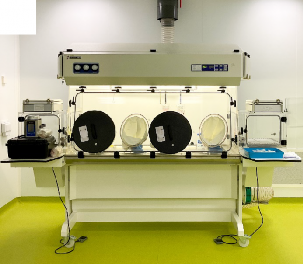 (a) (a) |
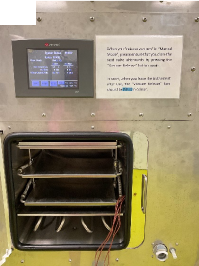 (b) (b) |
|---|
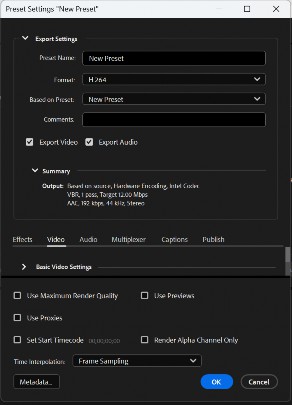
The Irish Journal of Technology Enhanced Learning Ireland is the journal of the Irish Learning Technology Association, an Irish-based professional and scholarly society and membership organization. (CRO# 520231) http://www.ilta.ie/ . This is an Open Access article distributed under the terms of the Creative Commons Attribution 4.0 International License (http://creativecommons.org/licenses/by/4.0).